
BenQ PD2710QC 27-Inch QHD IPS Monitor Review: The First Display With Built-In USB-C Dock
Introduction

In January of this year, BenQ announced the PD2710QC which may just be the perfect monitor for graphic designers, video editors and photographers. About three weeks ago we took an in-depth look at the BenQ PD2500Q which received our gold award for being an amazing designer monitor in the $300 price segment. Today we are going to review the BenQ PD2710QC that is also aimed at designers but this model is positioned more towards the higher end of the market and costs twice as much as the PD2500Q.
The BenQ PD2710QC is a 27-inch 60 Hz monitor with a 5ms (GtG) response time that retails for $600 on Amazon and comes with 3 years of warranty. It features an IPS panel with QHD resolution and a high build quality as we’ve come to expect from BenQ. I do want to mention that BenQ has been releasing some impressive monitors this year that have been generating a lot of positive attention for the company.
Features
What makes the PD2710QC truly stand out from the competition is the base. BenQ has integrated a built-in docking station into the base of the PD2710QC which includes a DisplayPort, a USB-C port, a USB hub, headphone jack and an RJ45 LAN port. On top of all that, there's also the standard I/O ports on the back of the monitor which includes one DisplayPort 1.2, one Mini DisplayPort 1.2, DisplayPort Out, and an HDMI 1.4 port so the connectivity options on the PD2710QC are overkill.
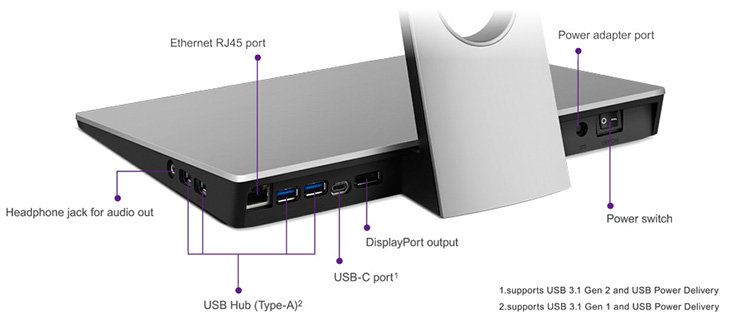
BenQ has factory calibrated the PD2710QC to produce the most accurate colors possible and they
include a printed report with the factory calibration settings in the box.
If you are someone who does graphics work for a living and are looking for a stylish, high-quality monitor, definitely consider the PD2710QC because
it comes calibrated by professional engineers to produce 100% sRGB and Rec. 709 color precision out-of-the-box.
BenQ has also said that all of their PD Series designer monitors will be professionally factory-calibrated going forward.
Two key features of the BenQ PD2710QC are the Flicker-Free technology and Low-Blue Light technology.
Flicker-Free Technology is used to reduce or eliminate flickering and effectively reducing eye fatigue
while the Low Blue Light technology combats the possible side effects of sleep disorder
that's produced from the blue light of computer monitors.
Surprisingly, BenQ has not included their Brightness Intelligence technology in the PD2710QC which
is used to detect the environment that you are in and change the brightness and color temperature of the monitor accordingly.
Performance
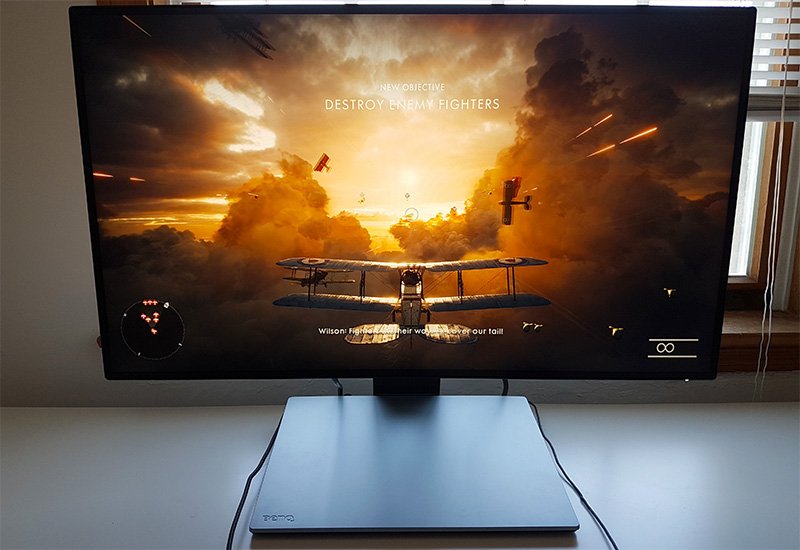
The PD2710QC is obviously not being targeted at gamers because it does not support G-Sync or FreeSync, and the refresh rate tops out at 60Hz. But that's not to say that you can't casually game with the PD2710QC. I fired up Battlefield 1 on maximum settings and started playing it on the PD2710QC for a few hours. To be honest with you, I can certainly see the PD2710QC being used for casual gaming because it outputs fantastic colors and everything in the game appears natural and vivid.
Digging further into the specs reveals that the BenQ PD2710QC relies on an 8-bit panel that can reproduce 16.7 million colors and is listed to cover 100% of the sRGB and Rec. 709 color spaces. Similar to the PD2500Q, the PD2710QC is also missing support for the Adobe RGB color space. When it comes to real world photography, sRGB normally gives better results and is considered to be much better for photography than Adobe RGB. With that being said, if you are someone who uses Photoshop, InDesign, and Illustrator, you might want to look for a different monitor.
Specifications
| BenQ PD2710QC Specifications | |
|---|---|
| Manufacture: | BenQ |
| Model: | PD2710QC |
| Screen Size: | 27" |
| Panel Type: | IPS Panel |
| Product Color: | Black/Silver |
| Aspect Ratio: | 16:9 |
| Brightness: | 350 cd/m² |
| Refresh Rate: | 60 Hz |
| Color Bit: | 8 Bit |
| Pixel Pitch (mm): | 0.216 |
| Native Contrast: | 1000:1 |
| Response Time: | 5ms (GtG) |
| Max Resolution: | 2560 x 1440 |
| Viewing Angles: | 178/178 |
| Color Depth: | 16.7M |
| Color Gamut: | 100% sRGB/Rec. 709 |
| Display Area (mm): | 596.7 (H) x 335.7 (V) |
| PPI: | 109 |
| DCR: | 20M:1 |
| Support: | Low Blue Light Flicker-Free |
| Audio: | 2 x 2W Built-in Speakers |
| Voltage Rating: | 100 - 240V |
| Power Supply: | Built-In |
| Power Consumption (On mode): | Monitor: 45W Base: 105W |
| Power Consumption (stand by mode): | 0.5W |
| Power Consumption (sleep mode): | 0.5W |
| Dimensions(HxWxD mm): | H:624.75 X 613.80 X 278.67 L:444.75 X 613.80 X 278.67 |
| Net Weight Without Stand: | 4.46kg |
| Net Weight (kg): | 7.4kg |
| Gross Weight (kg): | 10.4kg |
| Gamma: | 1.8 - 2.6 |
| AMA: | Yes |
| VESA : | Yes |
| HDCP: | 1.4 |
| Display Screen Coating: | Anti-Glare |
| Tilt (down/up): | -5° ~ 20° |
| Swivel: | 45˚/45˚ |
| Height Adjustment (mm): | 180 |
| Ports: | 1 x HDMI 1.4 2 x DisplayPort 1.2 1 x MiniDisplayPort 1.2 4 x USB 3.1 Downstream |
| USB Type-C: | Yes (PD61W, DP Alt mode, Data) |
| RJ45: | Yes |
| Warranty: | 3 Years |
| Release Date: | January 2017 |
Packaging
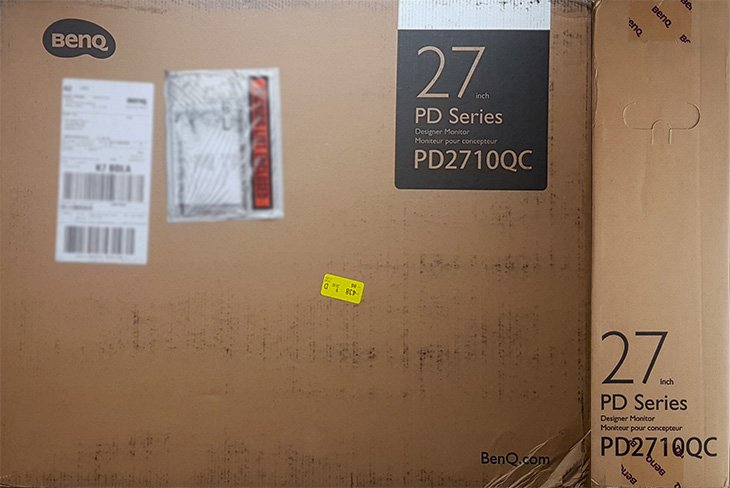
The PD2710QC comes in a basic brown carton with the monitor model number on the top right corner. On the sides you can will find some basic information about the monitor such as the 25" monitor size, PD series, PD2710QC model number and that it is a designer monitor.
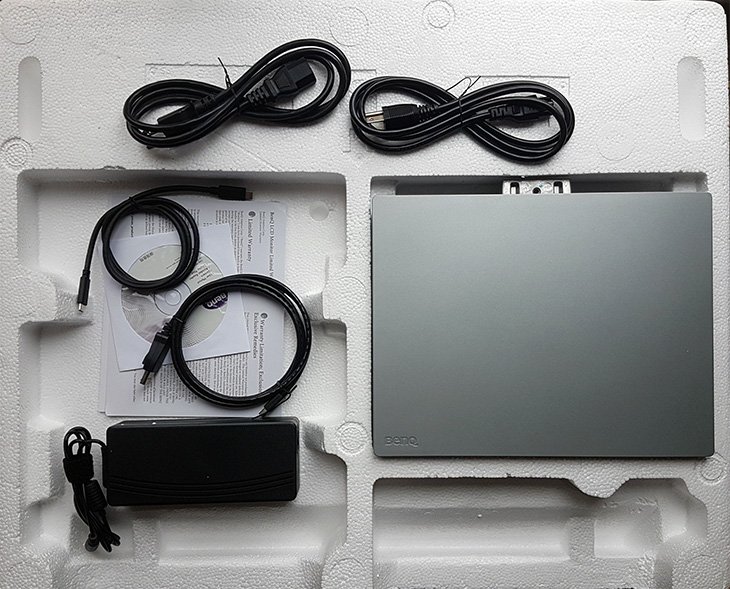
BenQ includes fairly decent quality cables and the components inside are well packaged and everything feels well secured inside the box. Inside you will find the 27” monitor, the stand/base, power cord, 1x HDMI 1.4 cable, 2x DisplayPort cables, 1x USB-C cable, a quick-start guide with documentation on a CD-ROM and a printed report with the factory calibration settings.
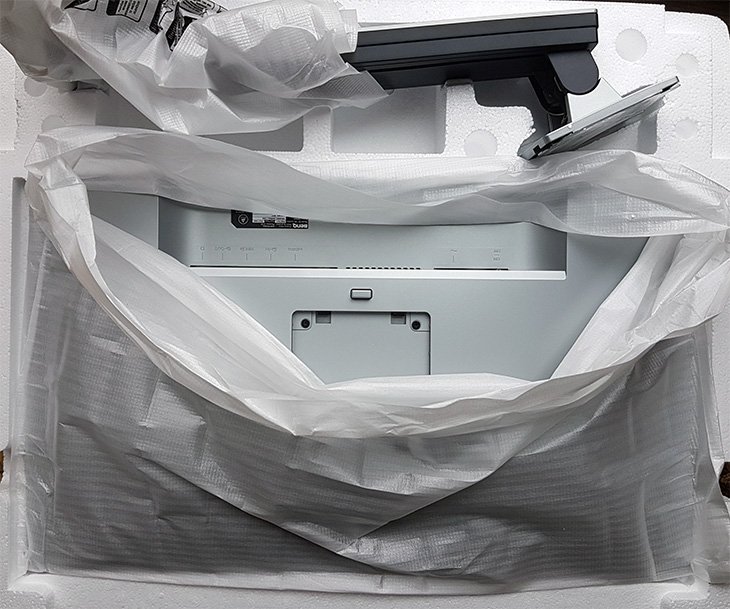
The monitor and the stand are tightly protected by two high density foams as shock absorbent and plastic wrapping to prevent any accidental damages during shipping. The packaging is good and the product arrived in perfect condition.
Design & Build Quality
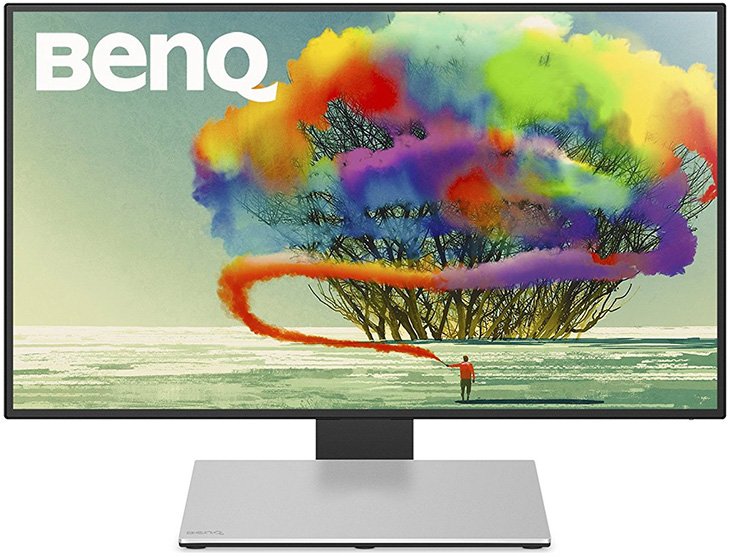
Visually, the PD2710QC looks unique and does not feature the all-black styling which we've come to expect from BenQ. The front panel is black but the rear panel and the base come in a silver plastic finish which is very pleasing to the eyes. Similar to the previous BenQ monitors that we have reviewed, the BenQ PD2710QC features a minimalistic and modern elegant design.
The display sports an anti-glare screen coating finish which makes it easier to see the screen under bright lights. The stand and base do not come pre-assembled but the installation process is very simple and won't take more than a few minutes. All you need is a screwdriver to connect the panel to the stand and the base attaches via a single thumb screw.
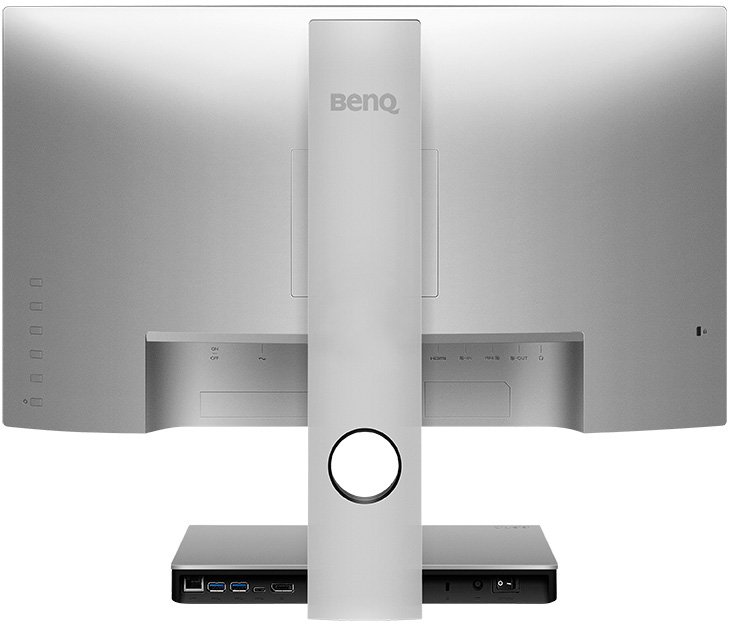
The top surface of the base is wide enough to hold a notebook and if you decide to use the docking station with a notebook, you have to use the DisplayPort cable to connect the base and the panel together. As far as the size of the base goes, it takes up quite a bit of desk space and it is about the same size as my Lenovo ThinkPad X1 Carbon 14".
When it comes to adjustments, you get up to 130mm of height adjustment which seems to be the norm nowadays, -5°/20° tilt (down/up), 45°/45° swivel (left/right) and the ability to pivot by 90°. The monitor stand makes it easy to adjust the positioning of your display to the most comfortable position without interfering with your work. The panel also offers 178-degree viewing angles and 5ms (gray to gray) response time. On the back of the monitor you will find your standard I/O ports, the BenQ logo and also your OSD buttons.
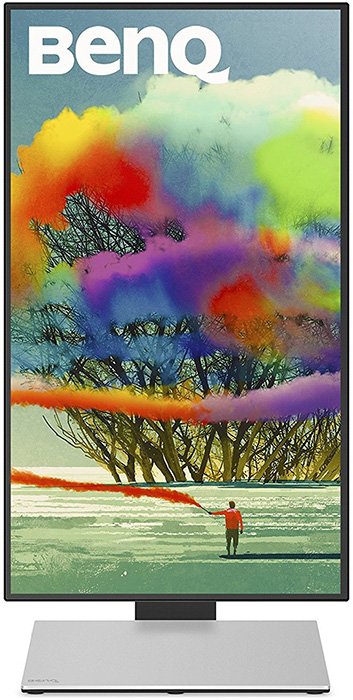
The PD2710QC is a unique product that comes with plenty of features to meet the needs of many type of users. BenQ has also added support for VESA mounting into the PD2710QC which might come in handy if you want to mount it to a stand or to the wall.
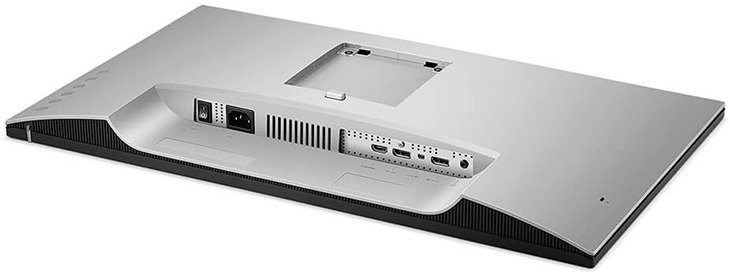
On the back of the PD2710QC, you will find the standard connectivity options which include one HDMI 1.4, two DisplayPort 1.2, one MiniDisplayPort 1.2, and four USB 3.1 Downstream. USB ports can be quite useful because they can be used for example to charge your smartphone while you are gaming or watching a movie.
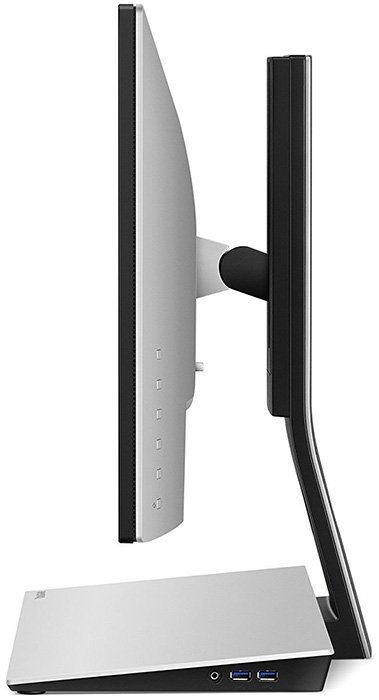
BenQ has done a good job making the PD2710QC slim on the side, and the PD2710QC is certainty one of the slimmest monitors that I have reviewed. In this side profile view, we also see the connectivity of the docking station which includes four USB ports, a single USB-C input, an Ethernet port, DisplayPort out, and a headphone jack. The USB-C port has a power delivery rating of 61 watts which makes the PD2710QC perfect as an all-in-one display for all your digital devices. The base comes with its own power supply so it does not interfere with the display panel.
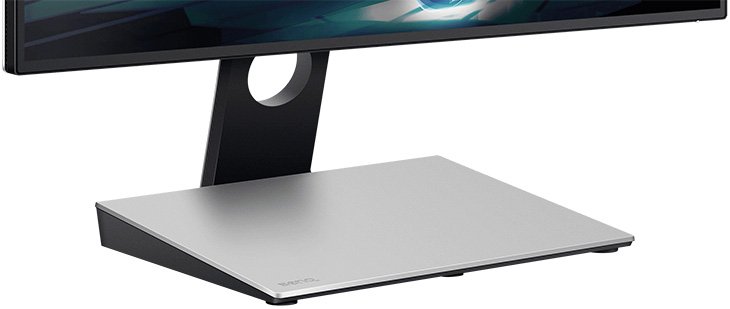
Like the other BenQ monitors that I have already reviewed, the PD2710QC also sports a plastic construction but it does not feel cheap. The stand offers solid stability and is quite sturdy and it doesn't wobble even if you move your desk around.
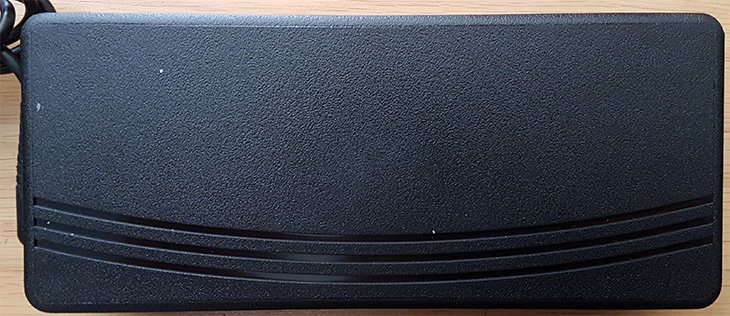
Typically, large monitors come with a big power supply and the PD2710QC is no exception. The power brick is used only for the base but the display itself has an integrated power supply. With that being said, the power brick for the base is huge and takes up quite a bit of space. It measures 170mm in width, 75mm in height, and 40mm in depth. But at least it comes with a ~4 feet long cable which makes it easier to hide it under the desk.
On-Screen Display & Panel
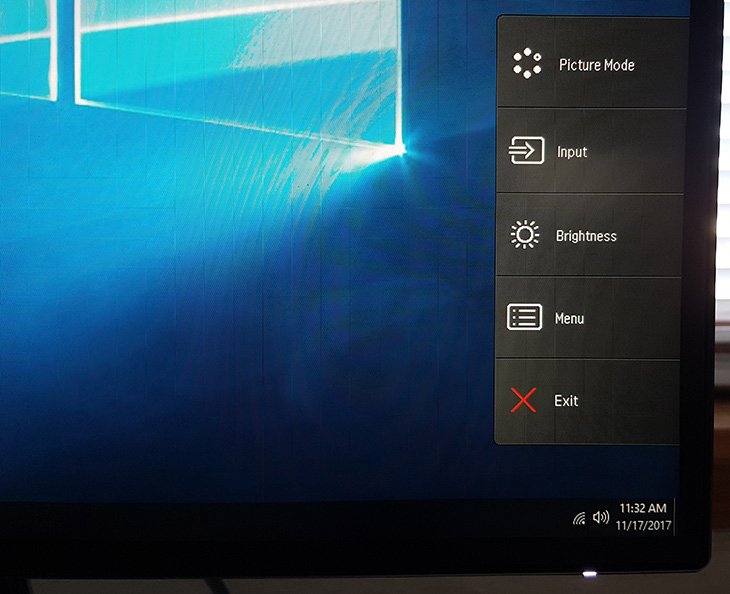
The on-screen display menu is easy to navigate and the buttons are located behind the display. The buttons are quite snappy and easy to press. Now let's go over the OSD setup. From top to bottom, the first setting is called picture mode, then we have input mode, after that comes brightness mode, and then comes the menu mode which is where you will spend the majority of the time customizing different settings.
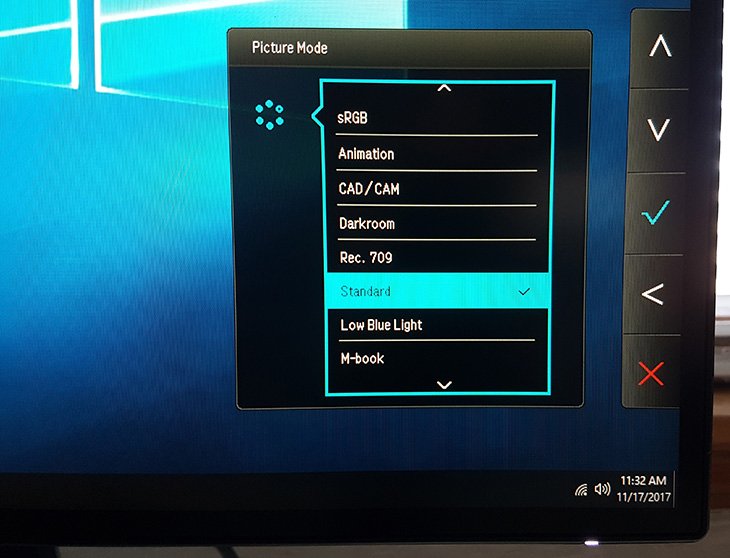
The Picture mode is self-explanatory and you can select between nine options. The monitor ships with the standard option as the default option but you can also choose between Rec. 709, sRGB, CAD/CAM, Animation, Low Blue Light, Darkroom, M-book and User.
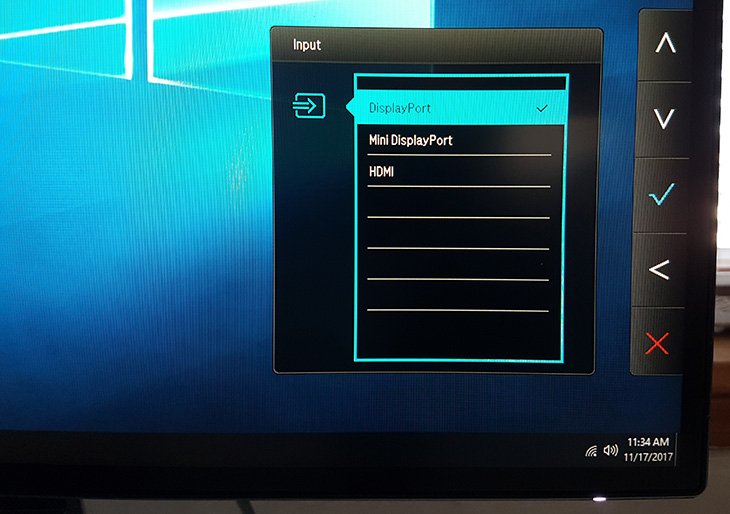
Moving on to the Input setting, here it will display whether you are using an HDMI, DisplayPort or mini DisplayPort connectivity.
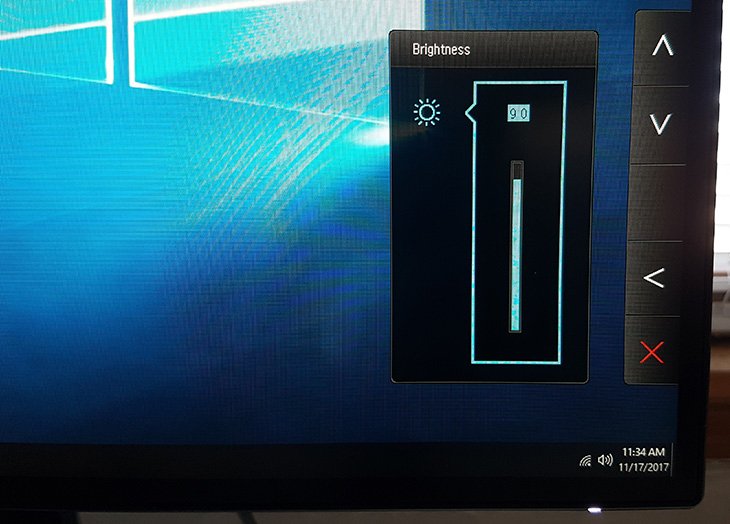
The Brightness mode is also pretty self-explanatory.
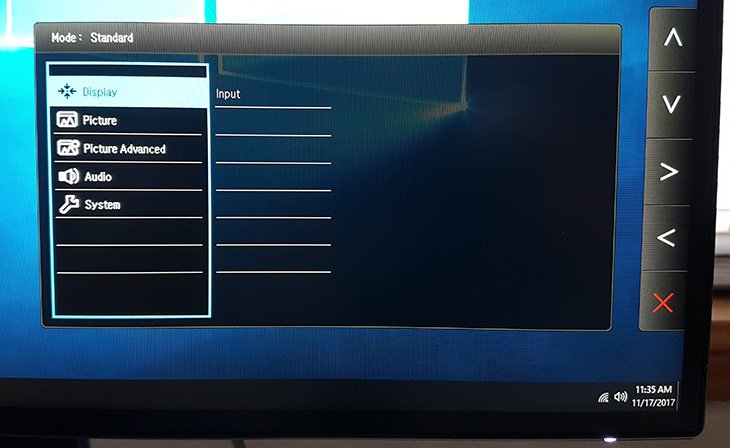
Now in the menu mode is where you will be spending most of your time. This is where you will go to play around with settings such as Display, Picture, Picture Advanced, Audio, and System. In the display section, you can only select the input option which is the same as what we already saw in the input screen.
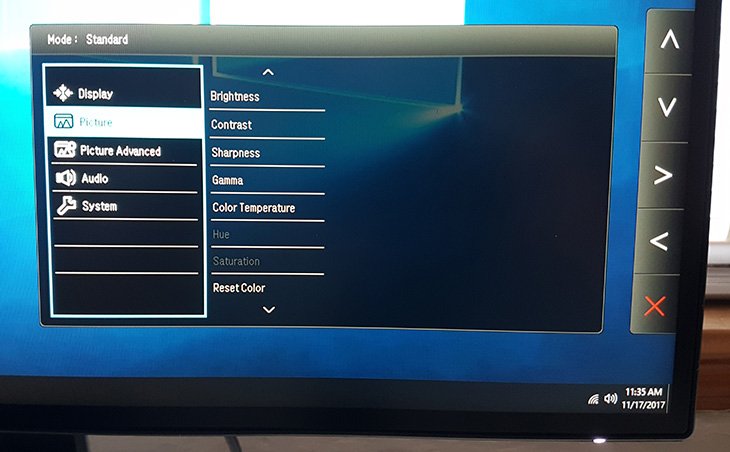
The Picture section provides control over Brightness, Contrast, Sharpness, Gamma, Color Temperature, Hue, Saturation, and Reset Color. Most of these settings can be left the way they are but if you find yourself making a lot of changes, you can easily reset all colors to default.
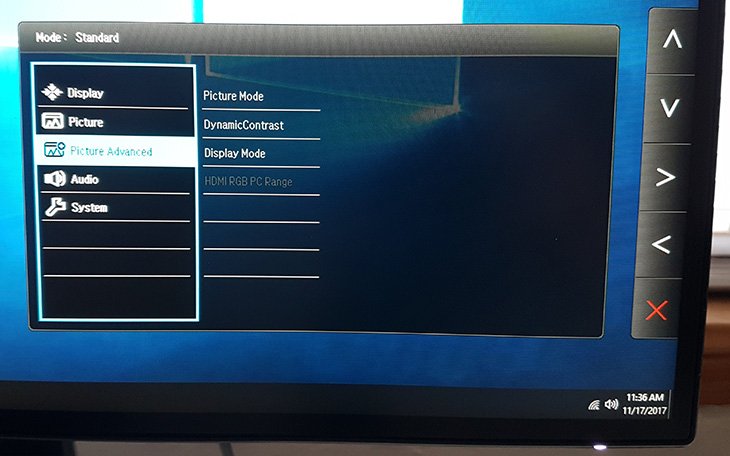
In the Picture Advanced setting, you can tweak Picture mode, Dynamic Contrast, Display Mode, and HDMI RGB PC Range. Dynamic contrast is used to allow the monitor to automatically adjusts picture detail and brightness.
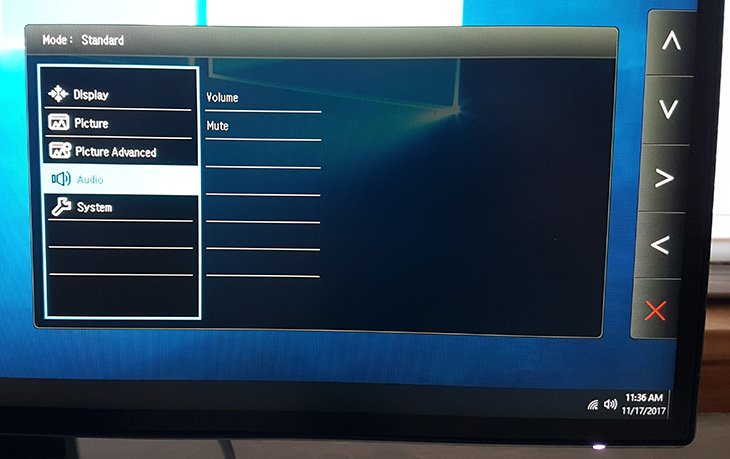
The audio setting is pretty self explanatory but like other BenQ monitors that I have already reviewed, the 2x2W built-in speakers are fairly low-quality and the sound output is low even when it is set to 100%.
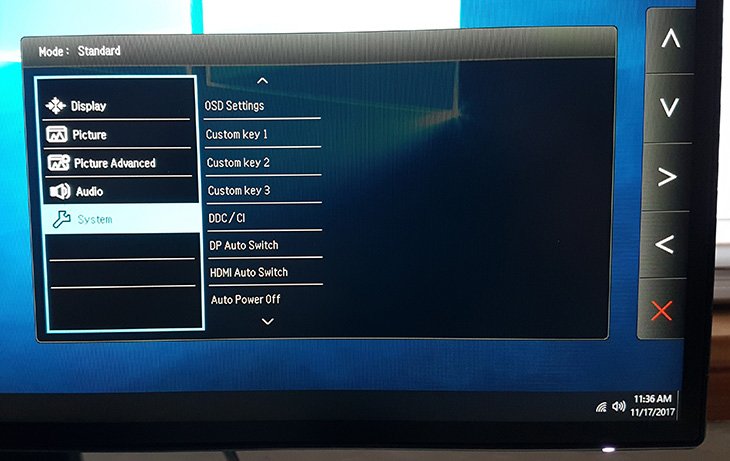
In the system section, you can tweak settings such as OSD Settings, CustomKey1, CustomKey2, CustomKey3, DDC/CI, DP Auto Switch, HDMI Auto Switch, Auto Power Off, Resolution Notice, Information, DisplayPort and Reset All.
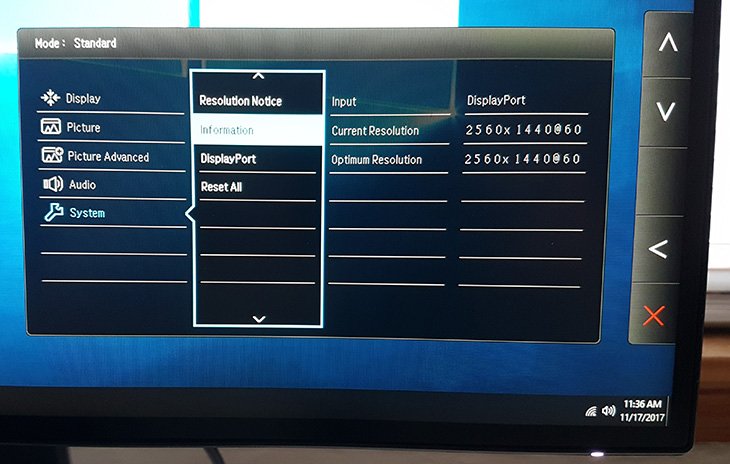
The Information option displays some basic information such as the resolution, refresh rate, monitor model, and input mode.

In most of BenQ's monitors you will find the BenQ logo located in the bottom center bezel but since the bezel is extremely thin on the PD2710QC, there wasn't enough to room to put the logo there.

Here's a close up picture of the frame and you can see that the PD2710QC features an extremely 7mm thin bezel. The panel goes all the way to the frame of the monitor and there is no gap between the screen and the frame. BenQ is using a 2-stage bezel design which is a very thin hard outer component and a panel border that appears to blend into the screen when the screen is turned off. We should start seeing true borderless screens in the near future but for now, technology has not reached that point yet and a 2-stage bezel design is as good as it gets.
Backlight Bleed & Viewing Angles
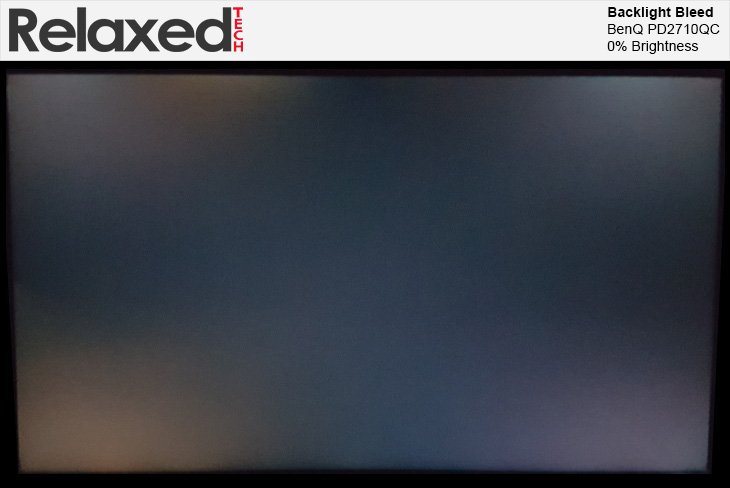
Now we are going to test the backlight bleeding at 0%, 50% and 100% brightness and the testing will be performed in a dark room.
Backlight bleeding is a major concern among enthusiasts and gamers because it is a major issue with IPS panels but not so much with VA and TN panels.
VA panels normally have superior blacks to IPS panels, but IPS panels typically have better color accuracy.
The above photo is tested at 0% brightness and you can clearly see that this monitor suffers from backlight bleeding even at 0% brightness.
You must keep in mind that nearly every IPS panel suffers from backlight bleeding so you should be expecting it.
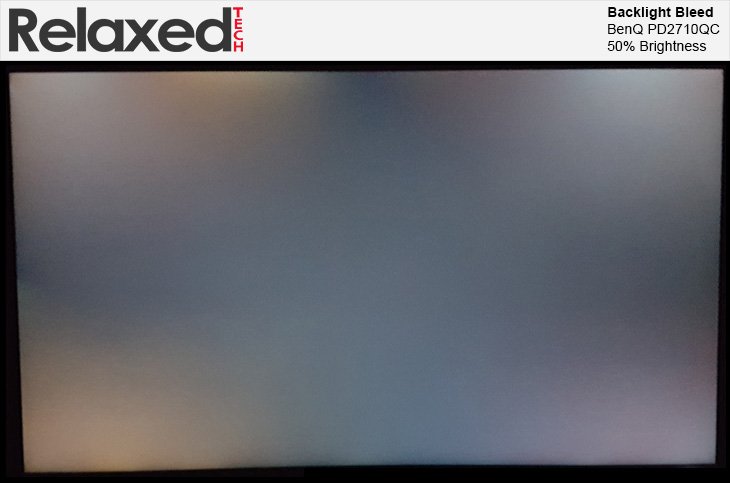
Here we are testing the backlight bleeding at 50% brightness.
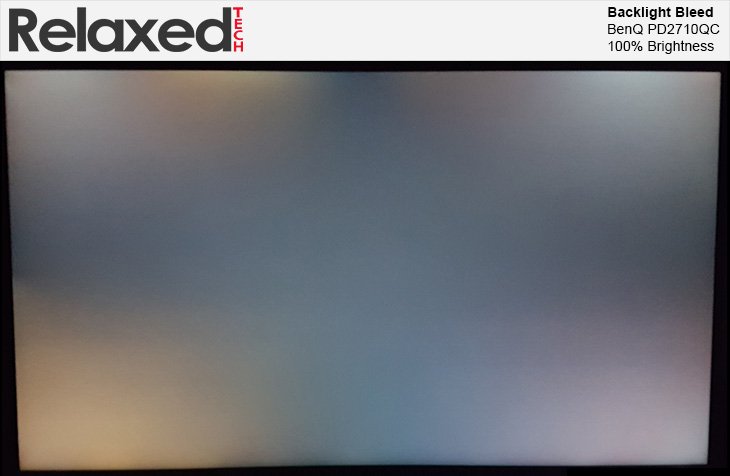
Now we are testing at 100% brightness and you can see a heavy concentration of backlight bleed or 'IPS Glow' in every corner of the screen, especially the bottom left corner.
I have spent about two weeks testing this monitor under different scenarios and I can tell you for certain that you won't notice the IPS glow when you are browsing the web, gaming, watching movies, etc.
Unless you are actively staring at each corner of the screen, it should not impact you in any way.
Keep in mind that IPS glow is something that all IPS panels suffer from and some panels have it worse than others but it doesn't
necessarily mean that you should be returning the monitor.
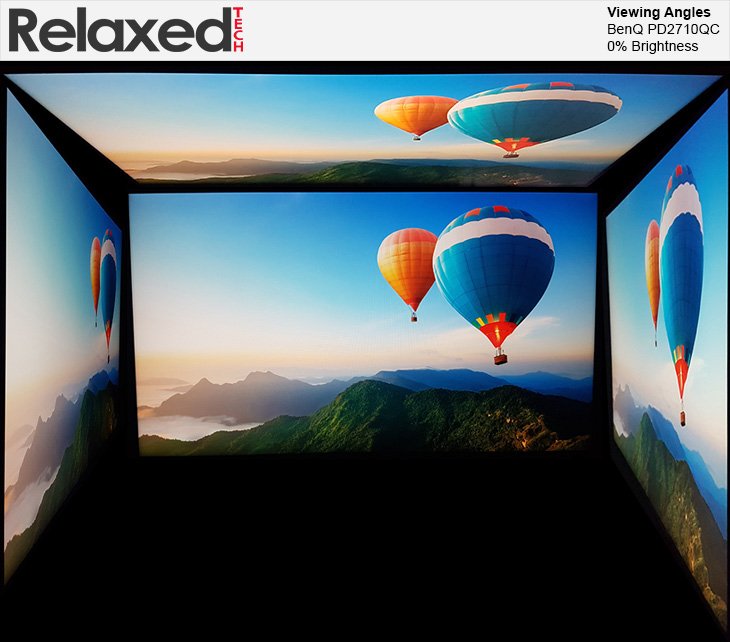
Now we are testing the viewing angles at 0%, 50%, and 100% brightness and the testing will be performed in a dark room.
The above photo was tested at 0% brightness and you can clearly see that the viewing angles are fantastic and the color uniformity is very good.
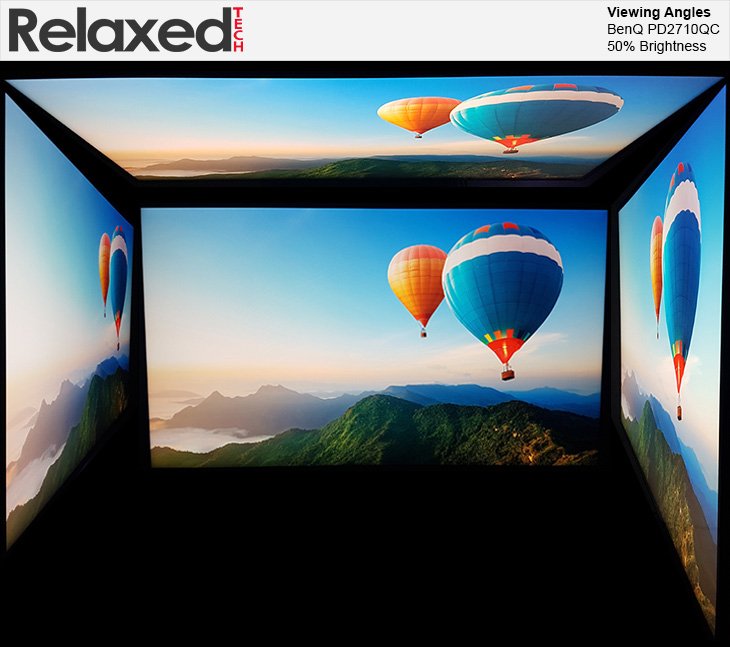
Now we are testing the viewing angles at 50% brightness.
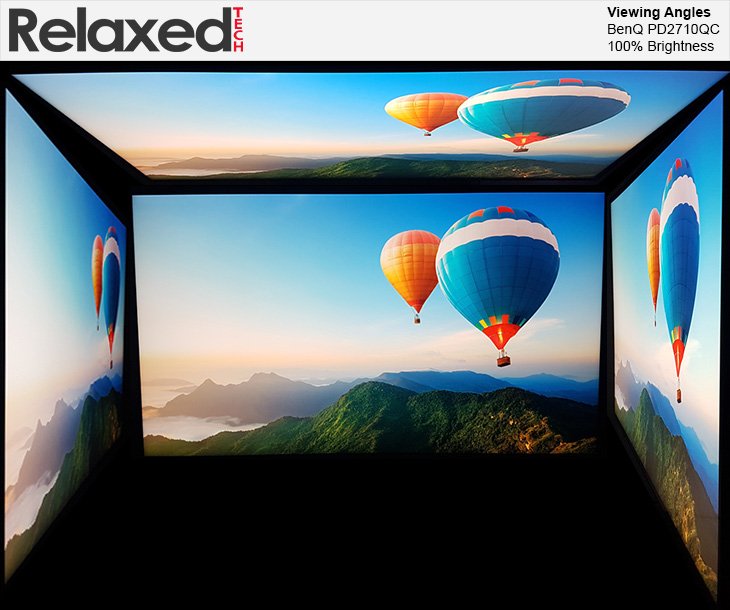
Here we are testing at 100% brightness. There was no color shifting or loss of luminance when viewed from an extreme angle during testing.
The colors stay true no matter what angle you're viewing the screen from and you can view the screen from basically any angle without distorting
the picture or losing color. Color reproduction is fantastic with this monitor which is expected from an IPS panel.
Conclusion
BenQ has done a superb job designing the PD2710QC. The PD2710QC has everything you can ask for in a high-end designer monitor. It sports a high build quality, fully adjustable stand, IPS panel, great color accuracy, and much more. On top of all that, it is loaded with connectivity options and comes with a full-featured docking station. It is even got a USB-C port that you can use to transfer your data, video, and audio files. Now I'm sure there are people out there who would have preferred Thunderbolt 3, but keep in mind that Thunderbolt 3 docks are normally priced around $300 and that would increased the price of the monitor even more.
Backlight bleed or 'IPS Glow' is very common with IPS panels and while the PD2710QC suffers to some degree from it, it's definitely bearable. Keep in mind that backlight bleed should not impact you in any way, unless you are staring at the corners of the screen. Moving on, the 2x2W built-in speakers are quite weak. They are fairly low-quality and even when the volume is set to 100%, the sound output is still too low.
The biggest downfall to the BenQ PD2710QC is its price. At $600, you can easily buy a 4K IPS 27" monitor but of course, chances are that it won’t include a built-in docking station that you get with the PD2710QC. There are plenty of users out there who only care about having a high resolution, and if you are one of those users, then you might want to look elsewhere. Personally, I think QHD still has a lot to offer, but I also think that 4K monitors are becoming mainstream and more affordable than ever before.
Pros:
+ Superb Color Accuracy
+ Three-Year Warranty
+ Built-In USB-C Dock
+ Factory Calibrated
+ Good Packaging
+ Thin Bezel
+ IPS Panel
Cons:
- Expensive
- Weak Built-In Speakers
- Base Takes Up A Lot of Desk Space
The PD2710QC is an excellent monitor with fantastic out-of-the-box color quality and I can safely recommend this monitor to creative professionals.
You don't have to waste your time calibrating different settings because BenQ has already done that for you and it shows as soon as you power up the monitor.
With a $600 price tag, the PD2710QC leans more on the expensive side which might push some people away.
Overall, the BenQ PD2710QC deserves our editor's choice award.
Final Score 9.4
